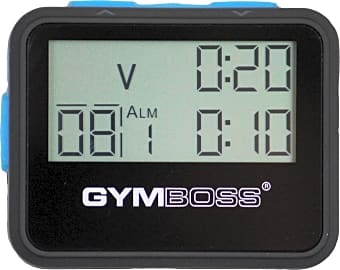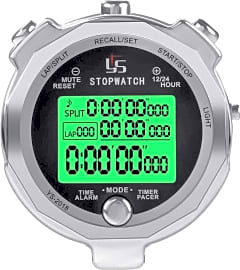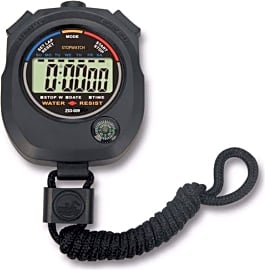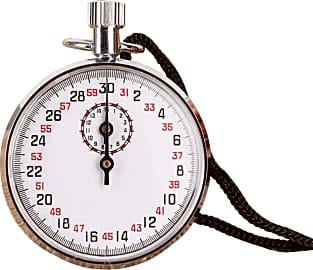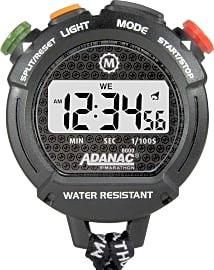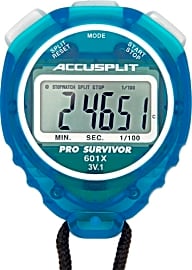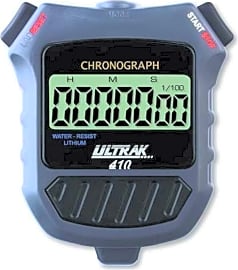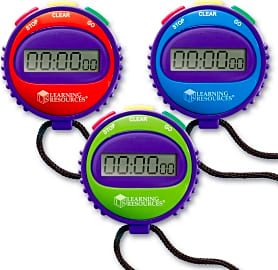The 10 Best Stopwatches

This wiki has been updated 39 times since it was first published in October of 2015. For serious athletes, timing is everything. These stopwatches can accurately monitor your performance and help you shave your minutes or seconds down to competitive levels. Whether you're running the 100-meter dash, training for a 5K, or simply going for a jog, one of these will have you covered. We've ranked them by accuracy, functionality, durability, and ease of use. When users buy our independently chosen editorial recommendations, we may earn commissions to help fund the Wiki.
Editor's Notes
March 25, 2021:
Many of our existing selections managed to make it through this round of updates, but we did wind up letting go of a few choices. The Casio HS-80TW-1EF Digital, Dakota Digi and Marathon ST21103 Mechanical were all removed due to availability issues, although we were careful to replace the latter model with the Moiak SXJ504, ensuring that our list maintained a suitable option for the old-school, analog diehards among us.
We also added the Rolilink Metal to our list, because we liked the way that its stainless steel housing brought a bit of class to our rankings, and we gave the Gymboss Interval a bit of a boost, in terms of its placement, because we recognized what an indispensable tool a decent interval timer can be to a training athlete. The Pgzsy Sport – which we ranked as a pack of 12, but is also available in packs of six or two – may not be the most impressive option we included, in terms of its design or functionality, but we judged that its staggeringly low price still merited inclusion on our list, even if only for the benefit of schools and gyms who go through these things regularly.
Speaking of which, if you are investigating this purchase on behalf of a school, gym or similar institution, then a stopwatch might do you just fine, but you’ll likely also be interested in considering our list of CrossFit clocks.
January 15, 2020:
There are plenty of cheap stopwatches on the market, so we felt it was a smart idea to seek out some models by more reputable names in the timekeeping industry, some of which are also renowned watch manufacturers. The Seiko S141 300 Memory and the Casio HS-80TW-1EF Digital both come from companies with long histories in timekeeping, but the Seiko managed to edge out the Casio despite the former displaying to 1/1000th of a second rather than 1/100th. That's mainly because the Seiko offers a slightly more comprehensive readout for split lap comparison, and it can count for longer.
We also saw fit to add an analog option to the bunch, and there are few better in the business for this than the makers of the Marathon ST211003 Mechanical. It's a manual-wind option, but it certainly gets the job done. And to make room for all of these, we had to say goodbye to some of the lesser models from our previous list, including the Travelwey Digital and the Insten LCD, both of which had inferior build qualities and screens when compared to the other budget options that remained.
Special Honors
GymNext Flex Timer With a 100-foot Bluetooth range, this gym clock offers you full, wireless control via smartphone app. Two sizes are available, and recommended for viewing distances of 20 feet and 30 feet, respectively. gymnext.com
Synergee Interval Timers There's plenty of situations that call for a handheld stopwatch that's nice and compact, but when you're dealing with a busy environment full of noisy athletes, there's often no substitute for a large interval timer with a loud buzzer. This company has three sizes to choose from, and they're available at fairly reasonable prices, too. iheartsynergee.com
Measuring Tasks By The Second
Regulation and regimentation of daily life is something that comes naturally to humans, plants, and animals.
Regulation and regimentation of daily life is something that comes naturally to humans, plants, and animals. Circadian rhythms, for example, serve to regulate many biological process over a 24-hour period. Even before the invention of the clock, humans have sought to organize time into quantifiable and measurable units in order make sense of the world around them. Examples of this organization include the conventional clock and stopwatch among other tools. The clock made it easier to divide an entire day into 24 separate parts. Each hour was determined to be the same length and could afford people a greater level of precision when it came to the planning of their schedules and the occurrence of events. The stopwatch takes clock logic a step further by giving a person control over even smaller units of time for a variety of measurement purposes.
Considered a form of chronograph, the stopwatch is a portable device that counts seconds or fractions of seconds, so they can be recorded accurately for the purpose of measuring elapsed periods of time. Three separate buttons located on the top of the stopwatch typically control its start/stop, reset/split time, and mode functions. Two consecutive pushes of the start/stop button will activate and freeze its timer, giving a user the chance to view the elapsed time on its display. The reset button clears the elapsed time, resetting the readout value back to zero. Also referred to as a cumulative split, the split time function can be used to record an even shorter subset of time independent from (but within the confines of) total elapsed time as the stopwatch runs. When using the split function, the stopwatch continues to measure overall elapsed time in the background. Cumulative split has particularly beneficial uses in sporting events, such as recording the length of time for individual laps in a race. Finally, the mode button allows a user to toggle between different operating modes.
Stopwatches fall into both mechanical and digital categories, with the latter being the dominant type on the market. Mechanical stopwatches are typically analog in style (with hands and a traditional clock face) and are powered by a mainspring that must be wound in order for the device to run. Digital stopwatches are powered by an internal alkaline or silver-oxide battery and operate by a combination of quartz crystal oscillators and electronic circuitry that measures specific time intervals.
So, what advantages does the stopwatch provide when it comes to measuring the passage of time in everyday life? One major benefit is that it's extremely easy to use. With only a couple of buttons to manage, there is very little fanfare involved in learning how to use it. This means its operation can be applied to many activities and controlled by both adults and kids alike. Next is the device's degree of accuracy and precision. It would be significantly more difficult to measure time in small quantities without something capable of recording fractions of a second and displaying them for a user to interpret. If we revisit our earlier racing example, we can understand that the use of a digital stopwatch allows for precise measurements of time, both in the form of individual laps and in the overall passage of time for an entire racing event. The same device can ensure accuracy for simple and domestic tasks, such as the amount of time needed to properly bake a casserole, or controlling the amount of time allowed for the kids to indulge in their video games during the weekend.
Keeping Time As A Digital Companion
Given its compact design and obvious portability, any stopwatch you invest in should be as durable as possible. Many of these devices are constructed from combinations of sturdy rubbers with plastic outer shells that are weather-, shock-, and impact-resistant, values that come in particularly handy when using them in aquatic environments or when playing high-action sports that require precise time measurements.
While many of the stopwatches on our list feature large, easy-to-read liquid crystal displays, always opt for one that gives you the choice of displaying both 12 and 24-hour values, especially if you're a coach or a runner.
If you plan to use your stopwatch as a regular clock, make sure the device comes equipped with audible alerts/ or alarms like many conventional digital watches.
A Brief History Of Stopwatches
The earliest stopwatch prototype was fashioned for English physician and surgeon Sir John Floyer by Samuel Watson in 1690. Referred to as the physician's pulse watch, this device was equipped with a both a second hand and a lever that, when pressed, could stop the internal movements of the watch and allow a doctor to accurately measure a patient's pulse rate.
The first wrist chronograph was developed in 1913, followed by the automatic chronograph in 1969.
The sale of a large silver timepiece called the compteur de tierces at a recent Christie's auction set the record straight as being the first practical stopwatch, invented by Frenchman Louis Moinet in 1816. Using hands like a modern stopwatch for astronomical research, Moinet's device was designed to measure the amount of time it would take for stars to cross the lens of a telescope.
Nicolas Mathieu Rieussec later developed a stopwatch in 1822 for the purpose of recording horse racing times at the order of King Louis XVIII. When activated, this stopwatch used a pen nib to deposit ink onto a strip of paper circling the rim of the watch dial. The dial was further marked at intervals down to one-tenth of a second. Ink would flow from the pen, essentially drawing an arc onto the watch face, so the passage of time could be determined by the length of the resulting arc.
By the 1870s, mechanical stopwatches were being used at race tracks, sporting events, and in the military. The first wrist chronograph was developed in 1913, followed by the automatic chronograph in 1969. The first digital stopwatch was produced by Accusplit in 1972.
Today, the versatility of the digital stopwatch makes it a relevant tool for a variety of industries and professions, including aviation, healthcare, sports, armies for supporting artillery, navigation, and even television production.


